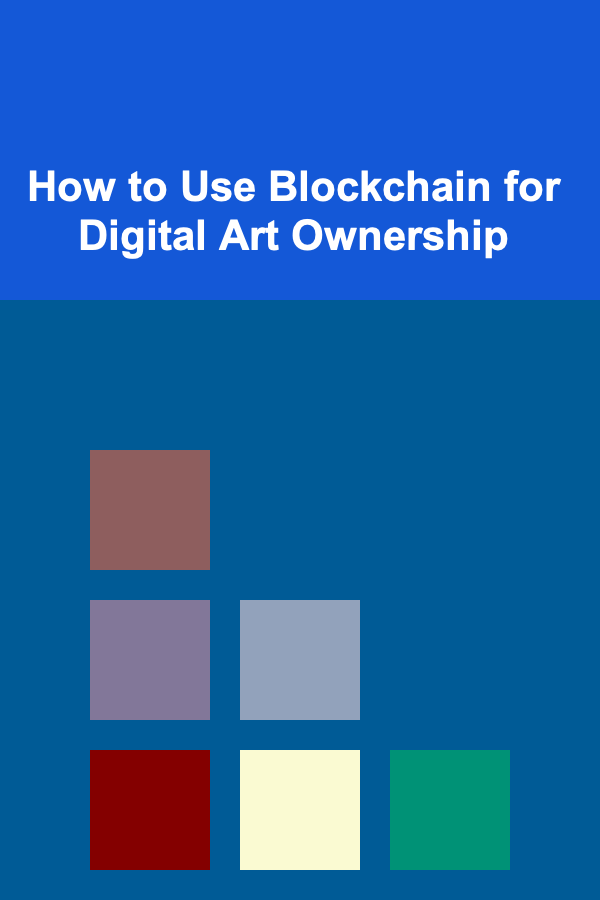
How to Use Blockchain for Digital Art Ownership
ebook include PDF & Audio bundle (Micro Guide)
$12.99$11.99
Limited Time Offer! Order within the next:

Digital art has exploded in popularity, with artists, collectors, and investors increasingly engaging with the virtual world. However, with this surge of interest comes the challenge of proving ownership, securing rights, and establishing clear provenance in a digital environment. Blockchain technology, which underpins cryptocurrencies like Bitcoin and Ethereum, has emerged as a powerful tool to address these issues, offering a decentralized and transparent solution for verifying and managing ownership of digital assets.
In this article, we will delve deeply into the intersection of blockchain and digital art ownership. We will explore the benefits of using blockchain for digital art, the mechanics behind blockchain-based ownership, and practical ways to leverage this technology. Whether you are an artist looking to sell your work or a collector interested in purchasing digital art securely, understanding the role of blockchain is crucial to navigating this new frontier.
The Rise of Digital Art
The internet has revolutionized the way we create, share, and consume art. Digital art, whether in the form of images, videos, music, or interactive pieces, has become a dominant medium in contemporary creative expression. With digital platforms and tools, artists can now reach global audiences and experiment with new forms of expression.
However, the digital nature of these artworks presents unique challenges. Unlike traditional art forms, digital art is easily replicable, making it difficult to establish clear ownership. A high-resolution image of a digital painting, for example, can be copied and distributed endlessly, leading to issues with attribution, authenticity, and copyright. These challenges create a need for a more secure, transparent system to prove ownership and provenance.
Blockchain technology, with its immutable records and decentralized structure, offers a solution to these problems by providing a way to verify the authenticity and ownership of digital art.
What is Blockchain?
At its core, blockchain is a decentralized digital ledger that records transactions across multiple computers in a secure, transparent, and tamper-resistant way. Each "block" in the chain contains a list of transactions, and once a block is added to the chain, it cannot be altered or deleted. This makes blockchain particularly useful for creating verifiable and permanent records of ownership and transactions.
Blockchain operates on a peer-to-peer network, which means there is no central authority or intermediary overseeing transactions. Instead, the network is maintained by a distributed set of participants (nodes) who validate and verify transactions. This decentralized nature ensures that no single party has control over the entire system, increasing security and reducing the risk of fraud.
How Blockchain Solves Digital Art Ownership Problems
Blockchain solves several key issues related to digital art ownership:
1. Provenance and Authentication
In the art world, provenance refers to the history of ownership of a piece of artwork. Establishing a clear provenance is essential for verifying the authenticity of a work and preventing forgery. Blockchain provides a permanent and immutable record of ownership that is publicly accessible and verifiable.
When a digital artwork is created and sold, its ownership details can be recorded on the blockchain. Each time the artwork is sold, transferred, or changed hands, a new record is added to the blockchain. This creates an unbreakable chain of ownership, allowing potential buyers to verify the artwork's authenticity and history before making a purchase.
2. Smart Contracts for Transparent Transactions
Smart contracts are self-executing contracts with the terms of the agreement directly written into lines of code. These contracts automatically execute actions when certain conditions are met, without the need for intermediaries. In the context of digital art, smart contracts can be used to automate the transfer of ownership and payment when a piece of art is bought or sold.
For example, an artist could create a smart contract that automatically transfers ownership of a digital artwork to the buyer once payment is made. Additionally, artists can include royalty clauses in their smart contracts, ensuring they receive a percentage of the sale price each time their work is resold in the future. This is especially important in the context of the secondary market, where traditional art sales often don't provide artists with compensation for resale transactions.
3. Digital Scarcity and Non-Fungible Tokens (NFTs)
One of the defining features of blockchain technology is its ability to create digital scarcity. Traditional digital files are easily duplicated, making it difficult to assign value to unique works. However, with blockchain, creators can mint unique tokens that represent ownership of a specific digital asset.
These tokens are called Non-Fungible Tokens (NFTs). An NFT is a type of digital asset that represents ownership of a unique item, such as a piece of digital art. Each NFT is stored on the blockchain and contains metadata that links it to the specific artwork it represents. The uniqueness and scarcity of NFTs make them ideal for proving ownership of digital art.
Unlike cryptocurrencies like Bitcoin or Ethereum, which are fungible (each unit is identical in value), NFTs are unique and cannot be exchanged on a one-to-one basis. This uniqueness gives digital art inherent value, as each NFT represents a one-of-a-kind piece of art that cannot be replicated or replaced.
4. Security and Ownership Control
Blockchain provides a high level of security through cryptographic encryption. Each transaction on the blockchain is verified by the network, and once a record is added, it is virtually impossible to alter or hack. This ensures that ownership details and transaction history cannot be tampered with, providing a secure system for tracking digital art ownership.
Moreover, blockchain enables artists and collectors to retain full control over their digital assets. Ownership of an NFT is recorded on the blockchain, and only the holder of the private key associated with that NFT has the right to transfer or sell it. This gives digital art owners complete control over their assets without relying on intermediaries like galleries or auction houses.
Practical Steps for Using Blockchain in Digital Art Ownership
1. Creating Digital Art and Minting NFTs
To use blockchain for digital art ownership, artists must first create their digital artworks. Once the artwork is ready, they can mint an NFT on a blockchain platform that supports NFT creation, such as Ethereum, Binance Smart Chain, or Tezos.
Minting an NFT involves creating a unique token that represents the digital artwork. This token is stored on the blockchain and contains important information, such as the artist's name, the artwork's title, a link to the digital file, and any other relevant metadata. The NFT also includes a smart contract that governs the terms of ownership and sale.
Artists can use platforms like OpenSea, Rarible, and Foundation to mint and sell their NFTs. These platforms allow artists to upload their digital artwork, set pricing, and define the terms of sale. Once the NFT is minted, it can be listed for sale in digital marketplaces where collectors can purchase it.
2. Buying and Selling Digital Art with NFTs
For buyers and collectors, purchasing digital art via NFTs provides a secure and verifiable way to own unique digital assets. When a buyer purchases an NFT, the transaction is recorded on the blockchain, and ownership of the NFT is transferred to the buyer's wallet. The buyer can then choose to hold the artwork in their collection, resell it on the marketplace, or even display it in virtual galleries.
NFTs are typically stored in a digital wallet, which can be a software or hardware wallet that supports Ethereum or other blockchain networks. These wallets allow users to manage their NFT collections, transfer assets, and participate in blockchain-based transactions.
3. Ensuring Royalties and Resale Rights
One of the most revolutionary aspects of NFTs is the ability to include royalties in the smart contract. This allows artists to receive a percentage of the sale price every time their artwork is resold on the secondary market. For example, an artist may set a royalty rate of 10%, meaning they will earn 10% of the sale price whenever the NFT is resold.
This feature is made possible by the programmable nature of smart contracts. Artists can embed royalty clauses directly into the NFT's smart contract, ensuring they are automatically compensated each time the artwork changes hands. This model is a significant departure from traditional art sales, where artists typically do not receive royalties for resale transactions.
4. Promoting Digital Art with Blockchain
Once an NFT is minted, it is essential to promote the artwork to potential buyers. Artists can leverage social media, digital galleries, and NFT marketplaces to increase visibility and attract collectors. Many NFT platforms feature promotional tools and community-building resources that can help artists gain exposure.
Additionally, blockchain-based art communities often host events, exhibitions, and collaborations to showcase digital artworks. These platforms provide a sense of community and a way for artists and collectors to engage with one another.
Challenges and Considerations
While blockchain offers numerous benefits for digital art ownership, there are also challenges and considerations to keep in mind:
- Environmental Impact: The energy consumption of some blockchain networks, particularly Ethereum, has been a point of concern due to the computational resources required for mining and transaction verification. However, many blockchain projects are working to transition to more energy-efficient consensus mechanisms, such as proof-of-stake.
- Market Volatility: The NFT market can be volatile, with prices fluctuating rapidly based on demand and trends. Artists and collectors should be aware of the risks involved and approach the market with caution.
- Legal and Copyright Issues: While blockchain provides a transparent record of ownership, it does not automatically resolve legal issues related to copyright and intellectual property. Artists and collectors must still ensure that they have the legal rights to the works they are minting or purchasing.
- Access and Inclusivity: Not all artists have access to the technology or platforms required to create and sell NFTs. The blockchain space is still developing, and there is a need for more inclusive solutions that allow a wider range of artists to participate.
Conclusion
Blockchain technology has the potential to transform the world of digital art ownership, providing a secure, transparent, and decentralized way to prove authenticity, track provenance, and manage rights. By leveraging blockchain, artists can retain control over their work, while collectors can confidently purchase and resell digital art with verifiable ownership.
As the adoption of blockchain and NFTs continues to grow, it will be interesting to see how this technology evolves and shapes the future of the art world. Whether you're an artist, collector, or investor, understanding how to use blockchain for digital art ownership is key to navigating this exciting new era of creativity and commerce.

How to Create a Pet Care Schedule That Works for You and Your Pet
Read More
How to Create a Toy Maintenance Schedule
Read More
How to Make a Checklist for Making Your Website Mobile-Accessible
Read More
How to Open a Consignment Store
Read More
How to Select the Best Baby Carrier for On-the-Go Parents
Read More
How To Improve Your Solo Performance Skills
Read MoreOther Products

How to Create a Pet Care Schedule That Works for You and Your Pet
Read More
How to Create a Toy Maintenance Schedule
Read More
How to Make a Checklist for Making Your Website Mobile-Accessible
Read More
How to Open a Consignment Store
Read More
How to Select the Best Baby Carrier for On-the-Go Parents
Read More